RESTful Web Service Listener Configuration
This implementation of the RESTful Web Service Listener allows the end user to accept RESTful Web Service calls to any resource in the system in any possible machine-readable format. The Listener is very flexible and configurable.
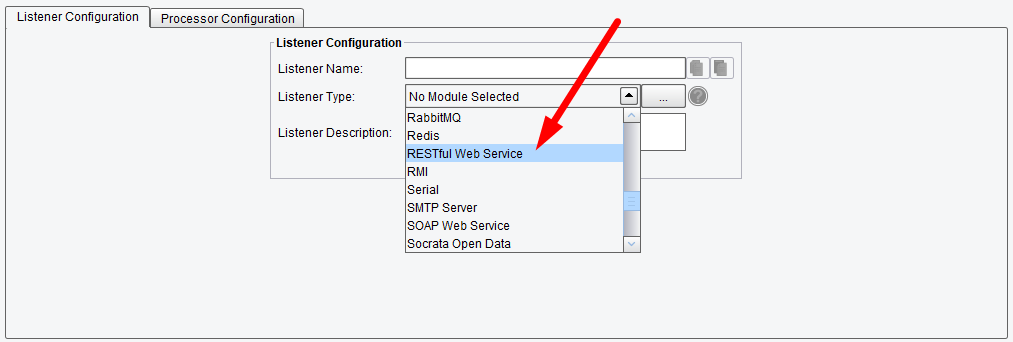
Listener (Adapter) Configuration Drop-Down List
The following parameters can be configured:
- Allowed HTTP methods. Users may want to set this web service to accept only GET and DELETE methods. In this case, PUT and POST requests will be ignored and the appropriate result returned to the requestor.
- Allowed Resources. As we described above, the Listener can accept calls to any resources specified in the body of the URL. But this list may be restricted in the Listener configuration.
- Listener request path.
- HTTP basic authentication credentials.
There are seven configuration tabs: Basic, Advanced, Transaction Logging, Inactivity, Throttling, Authentication, and Supported HTTP Methods.
Basic RESTful Web Service Listener Configuration Options
The Basic tab allows you to configure:
- REST Service Name – part of the HTTP path to listen to, for example ‘http://server.com/service/{ServiceName}/Car/21’. Service name should not contain ‘/’
- Supported Resources – list of the names of the supported resources
- Timeout – specifies how long the Listener should wait for messages which are interrupted before timing out the connection
- WADL File – WADL file that would be returned on request that ends with “?wadl”
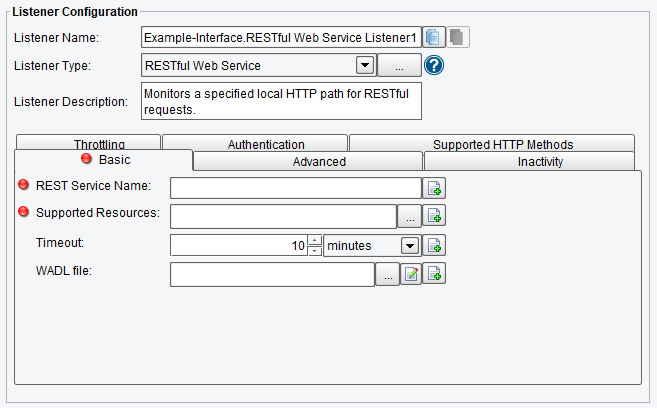
RESTful Web Service Listener Basic Configuration Options
Advanced RESTful Web Service Listener Configuration Options
The Advanced tab allows us to set the following settings:
- Initialize on Trigger Only – if enabled, the Listener doesn’t start up until a trigger initializes it
- Allow Command-Line Invocation – if enabled, the listener can be invoked using the CLI client application
- Restart on Listening Error – if enabled, the listener will be restarted after an error occurs
- FIFO Queue Name – the FIFO option enables a “First In, First Out” queuing mechanism between Listeners and Transports. If a FIFO Queue Name is provided, it will be used as a key for a transaction queue. Transactions will be written to this queue before they reach a Transport. The transactions in this queue will be ordered according to when they were created by the Listener.
- FIFO Queue Delay – this is the interval between updates and checks against that queue. Providing a queue name guarantees that a given Transport sends transactions in the same order the Listener created them in
- Require SSL – if selected, plain text requests will be rejected
- Synchronous – specifies whether or not a response is expected. To set response headers, see the “Synchronous Response Headers” section below.
- HTTP Headers – allows specification of HTTP header name-value pairs to use in synchronous response
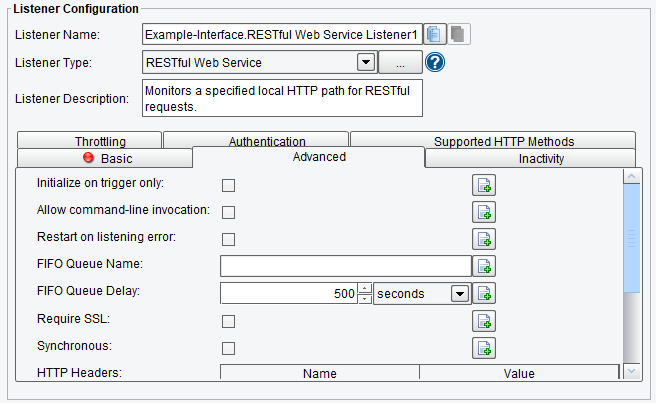
RESTful Web Service Advanced Configuration Options (top half of screen)
- Use Legacy Token Parameter – if true, legacy support for special handling for an authentication parameter called “token” will be enabled. This should only be used if this legacy behavior is required.
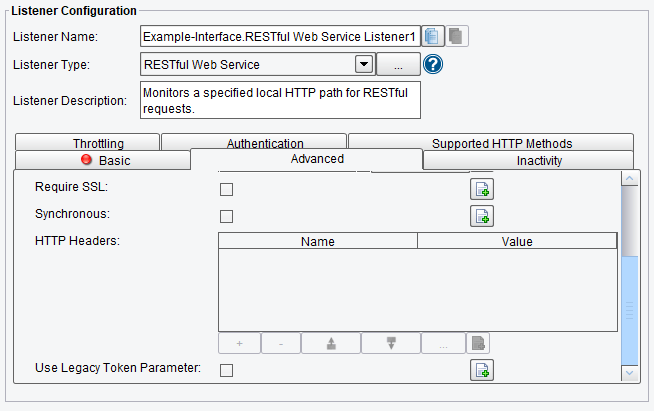
RESTful Web Service Advanced Configuration Options (bottom half of screen)
Inactivity RESTful Web Service Listener Configuration Options
On the Inactivity tab you can specify:
- Enable Inactivity Monitor – check this box to enable inactivity monitoring – this will throw a non-transaction exception if the specified number of transactions haven’t been processed in the specified time interval
- Minimum Transactions to Expect – the number of transactions to expect to be completed per monitoring interval
- Monitoring Interval – how often to check the specified number of transactions have been processed
- Times to Monitor – if set, monitoring will be done during the defined times of day – to ignore, set start and end time equally
- Days to Exclude from Monitoring – inactivity monitoring will not occur on the days specified
- Include Errors in Transaction Count – if checked, transactions that attempted to start but failed at the Listener stage will also be counted
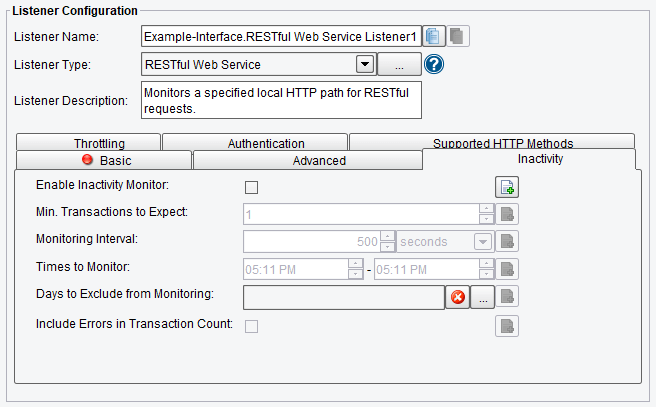
RESTful Web Service Listener Inactivity Configuration Options
Throttling RESTful Web Service Listener Configuration Options
On the Throttling tab, you can specify:
- Throttling Mode – the throttling mode to use for limiting the number of transactions or messages emitted by this Listener. “Timed” will limit transactions based on time intervals, while “Concurrent” will limit based on a concurrent number of transactions. “Concurrent” mode requires a Throttling Response Processor step later in your Interface workflow to acknowledge completion.
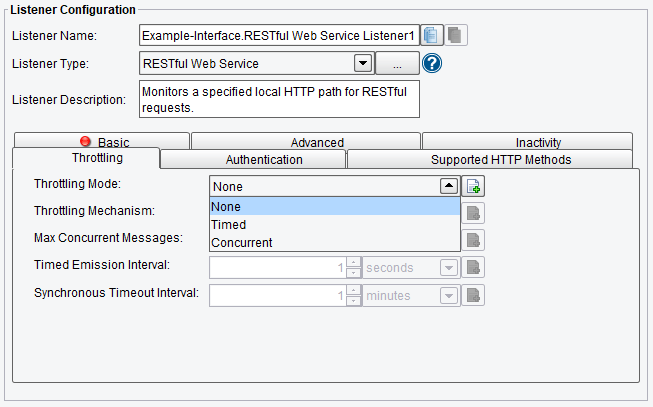
RESTful Web Service Listener Throttling Mode
- Throttling Mechanism – the mechanism to use for throttling messages. “Blocking” prevents the Listener from continuing to process and emit messages altogether, while “Queued” pushes received messages into the Interface queue or a default, in-memory queue.
- Max Concurrent Messages – how many messages can be concurrently processed, either by time-based limits (“Allow X per Second”) or synchronous (“Allow X at any Time”)
- Timed Emission Interval – the interval for time-based limits (“Allow X per X Timed Emission Interval”)
- Synchronous Timeout Interval – the interval to wait for a synchronous response before failing
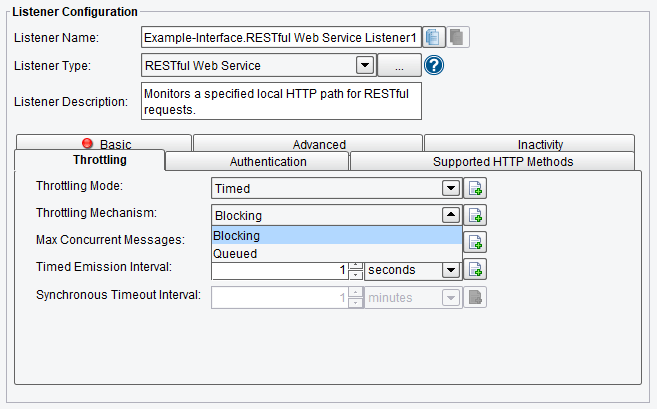
RESTful Web Service Listener Throttling Configuration Options
Authentication RESTful Web Service Listener Configuration Options
The Authentication tab allows you to set the following:
- User Name – enter the User Name(if necessary)
- Password – enter Password (if necessary)
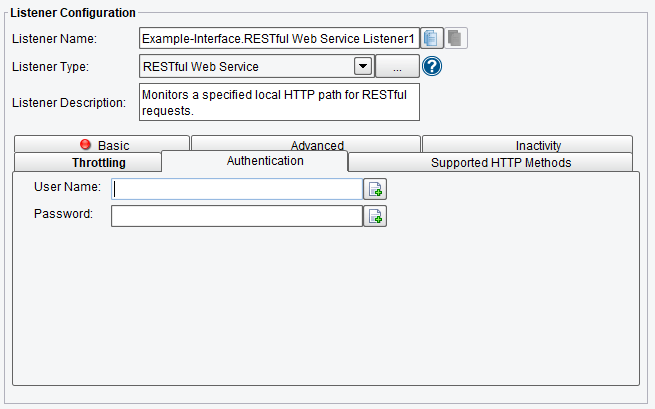
RESTful Web Service Listener Authentication Configuration Options
Supported HTTP Methods RESTful Web Service Listener Configuration Options
The Supported HTTP Methods tab allows you to set HTTP methods that would be used.

RESTful Web Service Listener Supported HTTP Methods Configuration Options
Synchronous Response Headers
You can specify synchronous response headers in a map that you store. That can be done in an HTTP Response Headers Processor.

Synchronous Response Headers Processor Options
If you’re curious about the software features, free trial, or even a demo – we’re ready to answer any and all questions. Please call us at 813 864 8662 or click the button.

